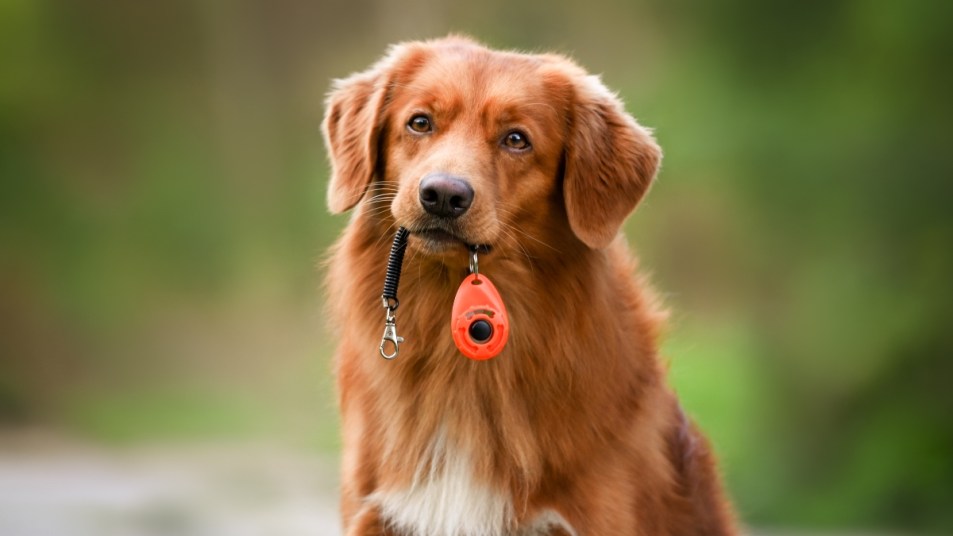When Dog Training, Use Positive Reinforcement (Versus Punishment) — Here’s Why
Build their trust and confidence.

In October 2020, Petco announced it had stopped selling shock collars online and in all of their stores. The major retailer had conducted a survey that found that after witnessing what happened to their dog when they released an electric shock to the pup’s neck, many pet parents didn’t want to do it again. In fact, 59 percent said they would rather shock themselves than their dog. This is one of several signs indicating the public’s increasing disdain for using punishment to train dogs. Instead, people are embracing positive dog training methods — due in no small part to growing scientific consensus.
For example, The American Animal Hospital Association’s Canine and Feline Behavior Management Guidelines oppose aversive training techniques, including prong or choke collars, cattle prods, alpha rolls, dominance downs, electronic shock collars, lunge whips, starving or withholding food, entrapment, and beating. The guidelines state that such techniques have “been associated with detrimental effects on the human-animal bond, problem-solving ability, and the physical and behavioral health of the patient. It causes problem behaviors in normal animals and hastens progression of behavioral disorders in distressed animals.”
Teaching Workers
The University of Pennsylvania’s Penn Vet Working Dog Center, which collects data about breeding and training working dogs, has found great success using positive training techniques, such as offering rewards for desired behavior, with a 94 percent graduation rate. The dogs then work with first responders and law enforcement as detection dogs finding narcotics, explosives, missing people, or human remains. Several dogs are also currently training to detect ovarian cancer and COVID-19.
The center’s founder, Cindy Otto, PhD, a veterinarian and 9/11 search-and-rescue dog handler, says the key is starting positive training when the puppies are 8 weeks old, and letting them “choose” their job — meaning they specialize in whatever they enjoy the most.
“Not only do they choose their own job, they choose their own paycheck,” she says. “Some dogs are not motivated by tugging on a toy, some are not motivated by a ball, and some are not motivated by food. We try to figure out what it is that’s the most rewarding for that dog.”
Trainers calibrate the reward to the training exercise. If a dog is learning to climb a ladder, a tug toy might be too exciting to keep attention on paw placement. So a motivating, but less stimulating, reward is in order, such as praise. However, in a situation where a dog already knows a skill and is trying it for the first time in a noisy environment, it’s safe to use an extremely motivating reward.
The Stress of Punishment
While some researchers like Otto have never actually done studies using punishment because positive training is so preferable, there are studies of coercive techniques on dogs who were already going through with them for legal reasons. In the United Kingdom, for instance, researchers observed pet dogs that were shocked electronically for pestering or attacking nearby livestock. The observers were not part of, nor did they condone, this technique, but they were able to watch. In terms of outcome, both shocked and positively reinforced dogs backed off the livestock to the same degree. But dogs trained with the electronic collar experienced much more stress. The study ultimately concluded that the use of shock collars “presents a risk to the well-being of pet dogs.”
Stress, fear, and anxiety can lead to reactive behavior in dogs, like growling, lunging, and biting, according to Lisa Radosta, DVM, a board-certified veterinary behaviorist at Florida Veterinary Behavior Service and correspondent for Top Vets Talk Pets digital media group. So punishing fearful animals seems counterintuitive to her. “If I had a kid who was scared, do you think I would put a metal collar around her neck, and every time she was scared, I would hurt her? Probably not,” she quips. “What would I do? I’d try to find ways to motivate her. I’d try to find consequences that are positive, that she could strive toward.”
Starting Young
In addition to using positive training methods, such as offering a treat when a dog chooses to “sit,” she strongly advises reducing fear by “socializing” or exposing puppies to a variety of people, pets, environments, and situations, particularly before they are 16 weeks old, in ways that make them feel safe.
Experts say that enrichment also helps set up dogs for success, and this can involve walks, games of fetch, puzzle feeders, nose work to sniff out hidden treats, and other activities to stimulate pets’ bodies and minds. “Sleeping all day just gives them energy to bark a lot,” Radosta says. “So the No. 1 rule of enrichment: Watch your dog, figure out what your dog likes, and take that thing and then blow it up into a thousand different things that you can do with your dog.”
Sarah Dunleavy, MAEd, NCC, a resident in counseling at Virginia Tech’s Thomas E. Cook Counseling Center, brings her therapy dog Wagner to interact with clients in group and individual sessions. The black Lab trained at the nonprofit Service Dogs of Virginia, where he was only rewarded for correct behavior and never punished for wrong behavior — a practice Dunleavy has continued.
Since Wagner is a facility dog at a mental health agency, it could disturb or upset clients if he barked. So when a new therapy dog walked past the door to Dunleavy’s office and her dog barked a warning, she didn’t yell or strike him. Instead, she used a happy tone of voice and petted Wagner when he came over for reassurance. Wagner understood the dog didn’t pose a threat — he was safe with Dunleavy — and he’s not barked again.
Happy Dogs
Dunleavy noted that if she punished Wagner in front of a client who had suffered abuse or other trauma, it could be triggering for them. So positive methods benefit Wagner as well as the people around him. The pup even learned to carry a tissue box to a crying client and lay his head in their lap. “He’s a happy dog,” she says. “When you have a well cared-for dog, they give back to their environment through their joy for life.”
Wallis Brozman, outreach programs specialist for Canine Companions for Independence, a nonprofit that trains service dogs for people with disabilities, is a three-time graduate of the program. So she understands on both a professional and personal level how effective positive training is for strengthening the bond on both sides of the leash.
“Having positive associations with performing tasks to assist a person with a disability is important for service dogs,” she says. Her service dog, Renata, loves her job and handler so much that she frequently brings Brozman her cellphone — not because anyone asks her to, but because the pup enjoys finding it and getting praise.
Giving Dogs the Freedom To Try
Like Renata, dogs that receive training with positive methods often start offering behaviors in case they lead to a reward. That creativity is crucial when working with pets with disabilities, according to Valeri Farmer-Dougan, PhD, professor and director of the Canine Behavior and Cognition Laboratory at Illinois State University. She frequently works with deaf and deaf-blind dogs.
“With punishment techniques, yeah, you’ll get quicker results and the dogs pay attention — because they’re afraid of you. But I think it really stifles new behaviors. It stifles their creativity. Dogs are afraid to try something new because they’re afraid of being punished,” she explains. “We need dogs who have a good bond with us, who want to work with us. And particularly for deaf-blind dogs who have limits already, we need them to be willing to try.”
Ultimately, how we train our dogs depends on the relationship we want to have with them. Clive Wynne, PhD, behavioral scientist and founding director of the Canine Science Collaboratory at Arizona State University and author of Dog Is Love: Why and How Your Dog Loves You, says while there are myriad reasons to choose positive training, the most important is that dogs truly love us and we want to strengthen that bond.
“I think our dogs love us and I think that we are in a strong, emotional, affectionate relationship with them. And I think it’s just a betrayal of that to bring pain into that relationship,” he says. “It undermines the loving, trusting bond that is the key pleasure in having a dog in your life.”
Positive Training In Action
Numerous proven strategies can help your dog overcome trauma, live a social life — and take on the world. The nonprofit Best Friends Animal Society successfully rehabilitated 22 dogs seized from former NFL quarterback Michael Vick’s infamous dogfighting ring in 2007. By using positive training methods customized to the needs of each “Vicktory Dog,” trainers encouraged the traumatized pups to learn to trust humans again. Most were adopted, though a few lived out their lives at Best Friends Animal Sanctuary in Kanab, Utah.
Marissa Sunny, CPDT-KA, behavior specialist for the Best Friends Animal Society, says customizing training is the key for working with any dog. Building blocks can include:
- Frequently say your dog’s name in a happy voice, instead of when you’re scolding.
- Learn your dog’s stress signs, such as “whale eye,” lip-licking, yawning, panting, and crouching.
- Use a clicker (an inexpensive tool available online and in pet stores) to pinpoint the exact moment your dog does something right. After marking that behavior with the sound of a click, reward with a treat, praise, or toy.
- Take breaks whenever a dog seems stressed or tired.
- When practicing the cue “Come” with an off-leash dog, make the reunion as happy as possible so they want to run back to you. “If you build that relationship with your dog, there will be much more respect and love,” Sunny says. “They’ll want to listen to you and you’ll have this give-and-take of communicating — more like parents with their kids.”
A version of this article appeared in our partner magazine, Inside Your Dog’s Mind, in 2021.













